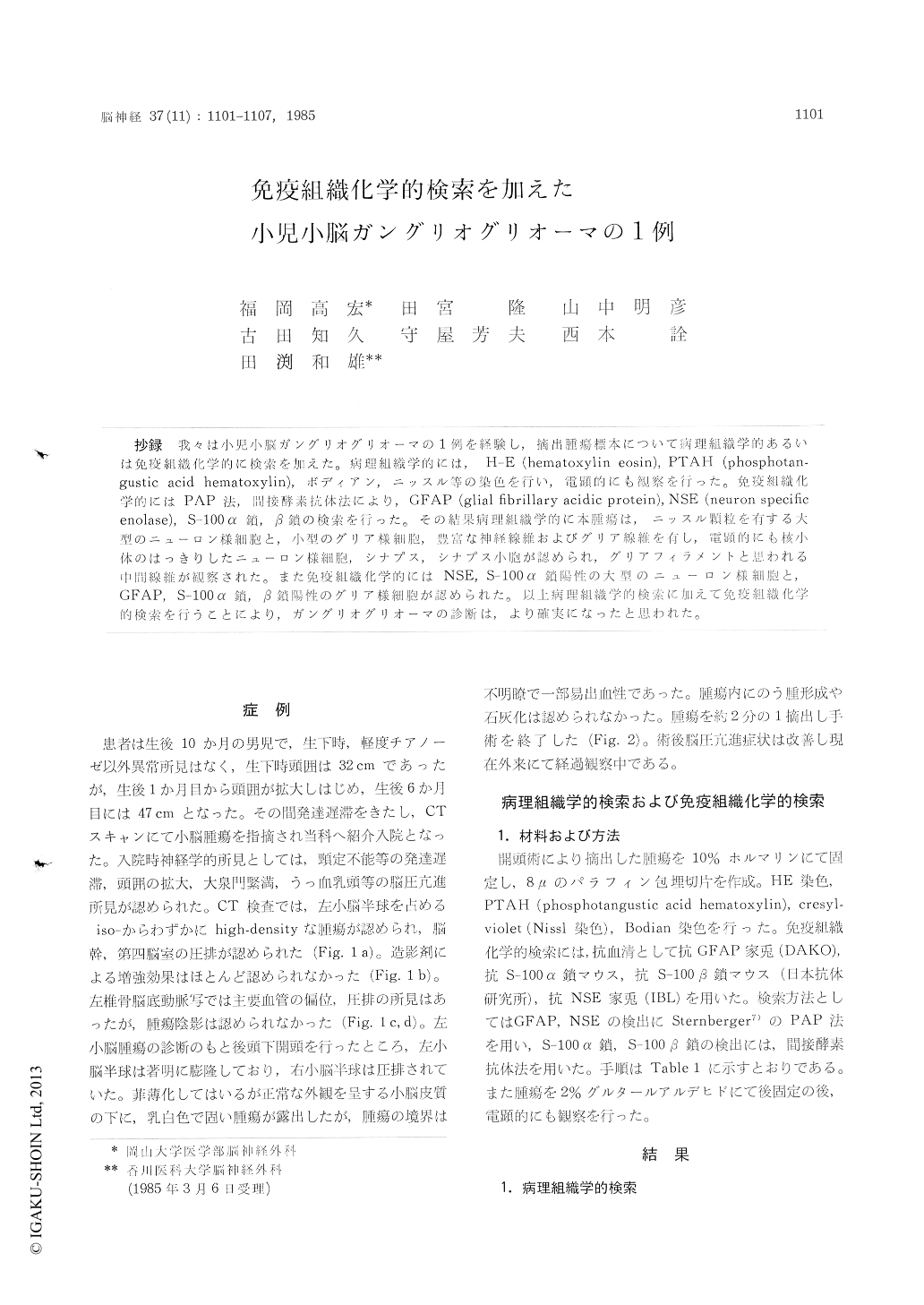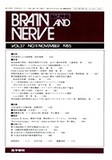Japanese
English
- 有料閲覧
- Abstract 文献概要
- 1ページ目 Look Inside
抄録 我々は小児小脳ガングリオグリオーマの1例を経験し,摘出腫瘍標本について病理組織学的あるいは免疫組織化学的に検索を加えた。病理組織学的には,H-E (hematoxylin eosin),PTAH (phosphotan—gustic acid hematoxylin),ボディアン,ニッスル等の染色を行い,電顕的にも観察を行った。免疫組織化学的にはPAP法,間接酵素抗体法により,GFAP (glial fibrillary acidic protein),NSE (neuron specificenolase),S−100α鎖,β鎖の検索を行った。その結果病理組織学的に本腫瘍は,ニッスル顆粒を有する大型のニューロン様細胞と,小型のグリア様細胞,豊富な神経線維およびグリア線維を有し,電顕的にも核小体のはっきりしたニューロン様細胞,シナプス,シナプス小胞が認められ,グリアフィラメントと思われる中間線維が観察された。また免疫組織化学的にはNSE,S−100α鎖陽性の大型のニューロン様細胞と,GFAP,S−100α鎖,β鎖陽性のグリア様細胞が認められた。以上病理組織学的検索に加えて免疫組織化学的検索を行うことにより,ガングリオグオーマの診断は,より確実になったと思われた。
Ganglioglioma is a rare brain tumor which oc-curs in an infant and young adult. The term "ganglioglioma" was originally proposed by Ewing in 1926 and subsequently adopted by Courville in 1930. Histogenesis of ganglioglioma is still spe-culative, but the hypothesis that ganglioglioma is derived from hamartomatous sympathetic neurons is generally thought to be probable. Ganglioglio-mas of the brain arise frequently from the tempo-ral lobe, frontal lobe, cerebellum and spinal cord.Its growth is gradual and clinically it is a benign tumor, but its malignant transformation has been reported. Ganglioglioina is a tumor composed of both neuronal and glial cells, but the ratio of these two-cell components varies a great deal from case to case and in different areas even of the same tumor. The authors experienced a cerebellar ganglioglioma in an infant which was successfully removed. Histopathological and immunohistoche-mical studies of the biopsy specimen have been done. That is, histopathological staining with H-E (hematoxylin eosin), PTAH (phosphotangus-tic acid hematoxylin), cresyl-violet and Bodian, and electron microscopical studies were perfor-med. Also the authors immunohistochemically exa-mined the presence or absence of GFAP (glial fibrillary acidic protein), NSE (neuron specific enolase), S-100 α and ,β subunits. Histopatholo-gically, the authors could find nerve fiber, glial fiber and identify neuronal cells which had Nissl-granules in the cytoplasm. Electron microscopi-cally the authors could distinguish the neuronal cells which had large nuclei and prominant nuc-leoli from the glial cells which had processes filledwith intermediate glial filaments. Sometimes, the author could find synaptic terminal-like structures with many spherical vesicle, but could not find any myelin formation in anywhere. The authors assume that these findings indicate so-called neu-ronal differentiation of the cell. Immunohistoche-mically the neuronal cells revealed positive stain-ing for NSE and S-100 α subunit, and the glial cells displayed positive staining for GFAP, S-100 α and β subunits. Thus, the authors could distin-guish the neuronal cell from the glial cell by immunohistochemical as well as by histoplatholo-gical studies. The authors believe that the immu-nohistochemical investigation is one of the useful methods to diagnose a ganglioglioma. It is very hard to determine whether this tumor is really true neoplasm or developmental anomaly. Radio-logically this tumor showed mass effect with in-creased intracranial pressure. Therefore, it is pre-sumed that this tumor has a neoplastic nature with gradual development of neurological abnormal-ity, while the patient was intact at birth.

Copyright © 1985, Igaku-Shoin Ltd. All rights reserved.


